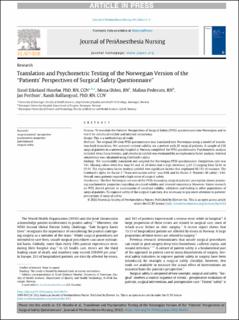| dc.contributor.author | Husebø, Sissel Iren Eikeland | |
| dc.contributor.author | Olden, Mona | |
| dc.contributor.author | Pedersen, Malinn | |
| dc.contributor.author | Porthun, Jan | |
| dc.contributor.author | Ballangrud, Randi | |
| dc.date.accessioned | 2023-03-15T13:16:27Z | |
| dc.date.available | 2023-03-15T13:16:27Z | |
| dc.date.created | 2022-12-07T08:48:51Z | |
| dc.date.issued | 2022 | |
| dc.identifier.citation | Husebø, S. E., Olden, M., Pedersen, M., Porthun, J., & Balllangrud, R. (2022). Translation and Psychometric Testing of the Norwegian Version of the “Patients’ Perspectives of Surgical Safety Questionnaire”. Journal of PeriAnesthesia Nursing. | en_US |
| dc.identifier.issn | 1089-9472 | |
| dc.identifier.uri | https://hdl.handle.net/11250/3058463 | |
| dc.description.abstract | Purpose
To translate the Patients’ Perspectives of Surgical Safety (PPSS) questionnaire into Norwegian and to test it for structural validity and internal consistency.
Design
This is a methodological study.
Methods
The original 20-item PPSS questionnaire was translated into Norwegian using a model of translation-back translation. We assessed content validity via a pretest with 20 surgical patients. A sample of 218 surgical patients in a university hospital in Norway completed the PPSS questionnaire. Psychometric analysis included item characteristics, and structural validity was evaluated by an exploratory factor analysis. Internal consistency was calculated using Cronbach's alpha.
Findings
We successfully translated and adapted the Norwegian PPSS questionnaire. Completion rate was 74%. Missing values were less than 5% and all 20 items had a high skewness (≥15 %) ranging from 52.8% to 95.9%. The exploratory factor analysis yielded two significant factors that explained 45.15% of variance. The Cronbach's alpha for Factor 1 “Team interaction safety” was 0.88 and for Factor 2 “Patient's ID safety”, 0.82. Overall, most patients reported a high sense of surgical safety.
Conclusions
The first Norwegian version of the PPSS measuring surgical patients’ perception shows promising psychometric properties regarding structural validity and internal consistency. However, future research on PPSS should provide an examination of construct validity, validation and testing in other populations of surgical patients. To improve safety of the surgical trajectory, it is necessary to pay more attention to patients’ perceptions of surgical safety. | en_US |
| dc.language.iso | eng | en_US |
| dc.publisher | Elsevier | en_US |
| dc.rights | Navngivelse 4.0 Internasjonal | * |
| dc.rights.uri | http://creativecommons.org/licenses/by/4.0/deed.no | * |
| dc.title | Translation and psychometric testing of the Norwegian version of the “Patients’ Perspectives of Surgical Safety Questionnaire” | en_US |
| dc.title.alternative | Translation and psychometric testing of the Norwegian version of the “Patients’ Perspectives of Surgical Safety Questionnaire” | en_US |
| dc.type | Peer reviewed | en_US |
| dc.type | Journal article | en_US |
| dc.description.version | publishedVersion | en_US |
| dc.rights.holder | The authors | en_US |
| dc.subject.nsi | VDP::Medisinske Fag: 700 | en_US |
| dc.source.pagenumber | 9 | en_US |
| dc.source.journal | Journal of Perianesthesia Nursing | en_US |
| dc.identifier.doi | 10.1016/j.jopan.2022.08.013 | |
| dc.identifier.cristin | 2089800 | |
| dc.relation.project | SHARE - Centre for Resilience in Healthcare: 5091 | en_US |
| cristin.ispublished | true | |
| cristin.fulltext | original | |
| cristin.qualitycode | 1 | |

